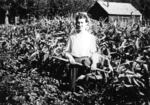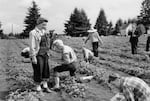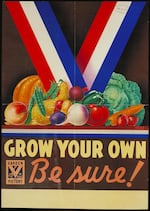
A woman working in a "Victory Garden" in Lake County, Ore., in 1944.
Oregon State University Libraries Special Collection and Archives
Spring weather and extra time at home may have you thinking about putting in or tending to a garden. It’s something past generations always did in times of turmoil. Home gardens provide extra fruits, veggies and herbs when store shelves may be bare.
During both World Wars, the U.S. government encouraged Americans to grow their own food to relieve shortages. Gardening was promoted as a family-friendly activity that provided exercise and stretched food budgets.

Residents tend to a strawberry patch in a Portland, Ore., "Victory Garden" in 1946.
Oregon State University Libraries Special Collections and Archives Records Management
With wartime food rationing in 1942, the Oregon Victory Garden Advisory Committee formed to help people grow personal plots of fruits and vegetables. Community groups and government agencies partnered to offer free public classes, they produced and distributed how-to manuals, provided hands-on assistance through home visits, and broadcast gardening information on KOAC radio – later known as Oregon Public Broadcasting.
The coordinated effort worked. All over the state, residents dug up and cultivated their yards, public parks, empty lots and even a portion of the Oregon Zoo.
“Every man, every woman, every child must be ready to take his place or her place. To do so requires health. One cannot expect to be physically fit, mentally alert, and ready to 'take it' unless a well-balanced diet, including plenty of fruits and vegetables, has provided that energy and fuel which is necessary to keep in top-notch condition all the time." — Milburn Wilson, Director of the USDA Extension, 1941”

A USDA poster from the 1940s promotes residents to grow their own "Victory Garden."
Library of Congress
At its peak in 1943, over two-thirds of U.S. households planted fruit and vegetable gardens, producing over 80 billion pounds of food, or 40% of the fresh produce eaten by U.S. residents that year.
The U.S. Department of Agriculture encouraged "Victory Gardens" through thousands of posters, pamphlets and advertisements.
"Oregon Experience" explores Victory Gardens and other ways Oregonians dealt with World War II in "Oregon at War."
[video: oregon-at-war,video_default,51392f3cff4edd4c60000004]
